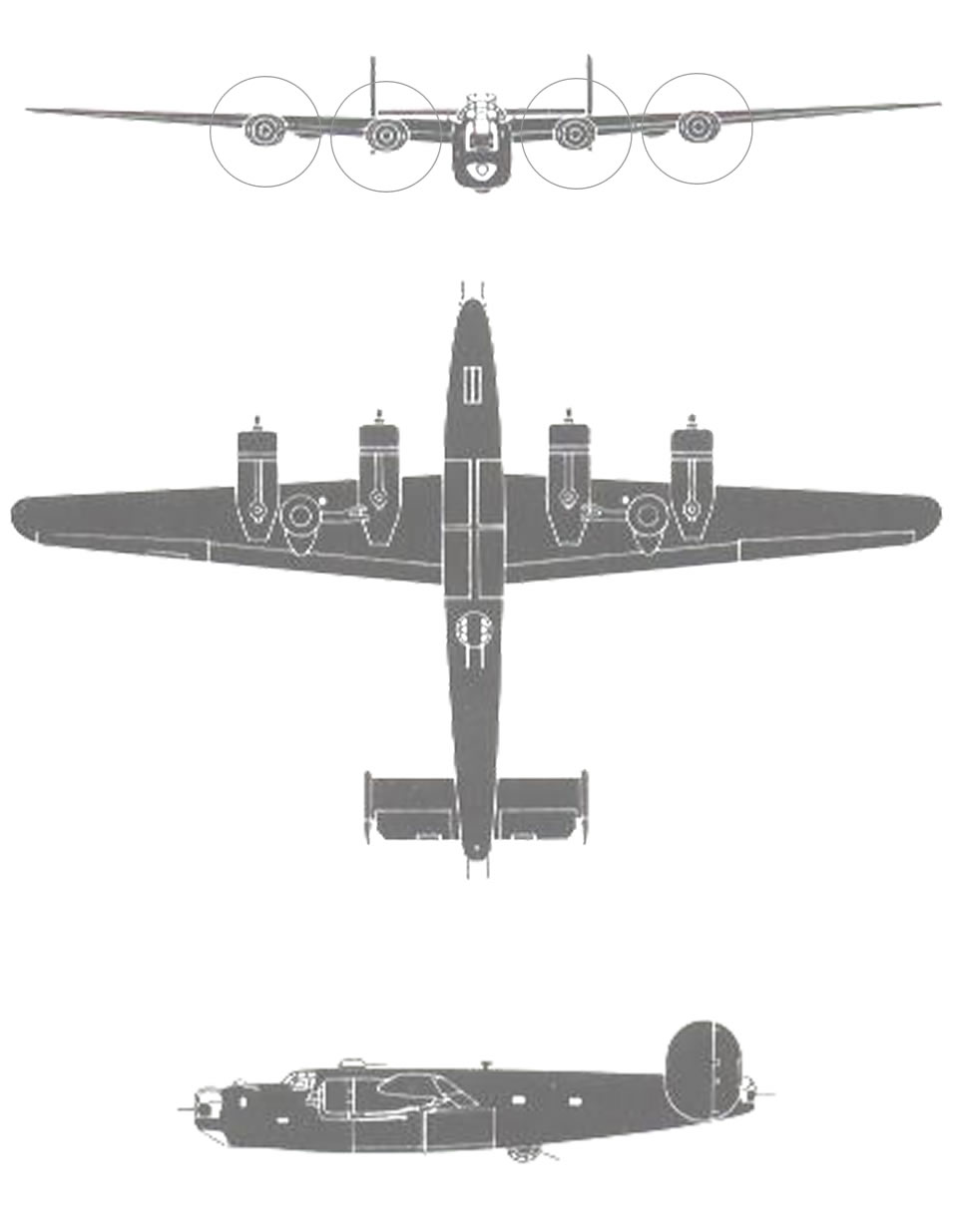B-24 Diamond Lil B-29/B-24 Squadron

Description:
Base:
Dallas, TX
Website:

| B-24 Specs | |
|---|---|
| Role | Heavy Bomber |
| Manufacturer | Consolidated Aircraft |
| Introduced | 1941 |
| Produced | 1940-1945 |
| Power | 4 × Pratt & Whitney R-1830-35 or -41 turbosupercharged radial engines, 1,200 hp |
| Length | 63 ft 9 in |
| Height | 18 ft 0 in |
| Wingspan | 110 ft 0 in |
| Range | 2,200 mi |
Contracted to be built for France in 1940 and later contracted to be diverted to Great Britain as AM927, this Liberator was the 25th built out of a total of 18,482 B-24s. The total number built is documented as 19,267 with the inclusion of all variants. This aircraft’s construction was completed as serial number 18 and accepted by the British Air Ministry in May 1941. Two days later, a Consolidated Aircraft Company (CAC) aircrew flew AM927 to Kansas City and handed it over to Trans World Airlines (TWA). TWA had been contracted to conduct flight crew training out of Albuquerque, NM. AM927 was then flown to what was called the TWA “Eagle’s Nest Flight Center” in Albuquerque, NM to be used to train RAF pilots.
The following month, Frank Burcham and Ned MacKrille, TWA instructor pilots, were practicing landings. The right main brake locked up during landing and aircraft departed the runway. The right gear collapsed, followed by a nose gear failure, before they came to a stop. There was also significant damage to the bomb bay. Consolidated initiated a recovery effort over the next 6 months and in December of 1941, the aircraft was flown back to the Consolidated Aircraft Company in San Diego. Due to the aircraft being damaged too far to be returned to service as a bomber, but still flyable, a loan arrangement was made between the British Ministry and Consolidated Aircraft Company for the company to keep possession of AM927 for logistic support and further B-24 development.
AM927 was immediately utilized as the C-87 Liberator Express prototype and returned to service in July 1942. Throughout the war, the aircraft was used to haul personnel and equipment between the five B-24 production plants and numerous vendors. She was also used extensively for flight test purposes developing such things as improved flight control characteristics for the later model Liberator bombers. After the war’s end in November of 1945, actual ownership of AM927 was given to Consolidated Vultee. At this time the aircraft was given registration number NL24927. Numerous modifications were made between 1945 and 1947 to improve performance and sustainability that included the long RY-3 nose and PBY nacelle assemblies.
On November 10, 1948 the aircraft was sold to the Continental Can Company. The aircraft was repainted and outfitted with a luxury interior. The company utilized AM927 for executive transport and cross-country flights between its North American plants for the next 10 years.
In April 1959 the aircraft was sold and exported to the Petróleos Mexicanos (Pemex) Mexican state-owned petroleum company. The Registration became XC-CAY and it was used to transport personnel throughout Latin America and the United States. In 1967, Pemex decided to upgrade and replace AM927 with a DC-6 aircraft. At this time, AM927 was loaned to the Commemorative Air Force who eventually took full ownership of the aircraft in May 1968. It was Registered as N12905 until 1990 when it was Registered as N24927. In 1972, AM927 was painted in the colors of the 98th BG, of the Ploesti Raid, and given the name Diamond Lil. During 2006-2007 the aircraft was reconfigured back to her B-24A/RLB-30 roots and was given the Ol' 927 nose art.
In April 2012, the CAF’s long-time Liberator legacy and nose art Diamond Lil was returned. On May 26, 2012, Diamond Lil experienced a complete hydraulic failure and suffered a subsequent nose gear collapse, in Charlotte, North Carolina. Temporary repairs were made and the aircraft was flown back to Addison, Texas. Because of the need to fabricate many replacement parts, restoration was not complete until July of 2013.
Since mid-2013, Diamond Lil has been touring the U.S. providing new and older generations the opportunity to experience this rare aircraft through aircraft tours and ride flights.
The Consolidated B-24 Liberator is an American heavy bomber, designed by Consolidated Aircraft of San Diego, California.
The B-24 was used extensively in World War II. It served in every branch of the American armed forces, as well as several Allied air forces and navies, and saw use in every theater of operations. Along with the B-17, the B-24 was the mainstay of the US strategic bombing campaign in the Western European theater. Due to its range, it proved useful in bombing operations in the Pacific, including the bombing of Japan. Long range anti-submarine Liberators played an instrumental role in closing the Mid-Atlantic Gap in the Battle of the Atlantic.

